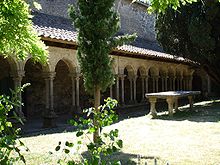Villelongue monastery
| Cistercian Abbey of Villelongue | |
|---|---|
 The monk choir |
|
| location |
Region Okzitanien Département Aude |
| Coordinates: | 43 ° 18 '20 " N , 2 ° 10' 1" E |
| Serial number according to Janauschek |
311 |
| Patronage | St. Mary |
| founding year | 1149 |
| Year of dissolution / annulment |
1791 |
| Mother monastery | Bonnefont Monastery |
| Primary Abbey | Morimond Monastery |
|
Daughter monasteries |
no |
The Villelongue Monastery (Villa longa) is a former Cistercian abbey in the commune of Saint-Martin-le-Vieil in the Aude department , Occitania region , in France . It is located around 21 km northwest of Carcassonne on the Vernasonne River .
history
The monastery was founded in 1149 at a place called Compagnes in the Montagne Noire north of Saissac by the monk Guillaume, who had come from Bonnefont monastery . The new monastery thus belonged to the filiation of the Morimond Primary Abbey . Around 1170 it was relocated to its current location, which is more climatically favorable. It was furnished by the Viscount of Carcassonne and the Lords of Saissac. From 1180 the stone monastery was expanded. The Albigensian Crusade , in which four of his abbots participated, brought wealth to the monastery. Villelongue took over the patronage of the Rieunette nunnery . At the beginning of the 14th century the monastery had over 30 monks. The monastery included the Grangien Le Conquet, Rascagnal, Trèbes, Camp des Caus, Puech-Auriol, Puech-Aldebert as well as the priories Saint-André de Fraissinède, Saint-Julien-de-l'Escau, Mas de la Garrigue and Saint- Sébastien de Madagens. Soon afterwards, however, the decline began, which was accelerated by the black plague (1348). The subordination to the Kommende in 1560 led to a further spiritual decline. In 1568 there was a pillage by the Calvinists. Towards the end of the Ancien Régime, the monastery, inhabited only by two or three monks, fell into disrepair until it was dissolved and sold during the French Revolution . Subsequently, parts of the plant were demolished. The repeatedly changing owners in the 19th century adapted the remaining parts to the needs of agriculture. The refectory became a horse stable, the Konversenbau a sheepfold and the chapter house became a wine store. In 1899 the monastery came into new hands and in 1916 it was classified as a monument historique . A Society of Friends of the Abbey has existed since 1984.
Buildings and plant
The eastern parts of the originally 57 m long, ribbed vaulted church have been preserved, namely the eastern nave yoke, transept with two straight closed chapels on the eastern sides and the dormitory staircase in the south and the flat closed choir with three arched windows and a rose window, whose tracery has been lost is. The figurative decoration contradicts the Cistercian rule. The southern gallery of the cloister has been restored, the capitals are adorned with foliage, monsters and animals. The three other galleries no longer exist. In the eastern part of the enclosure in the sacristy remains of frescoes from the early 13th century have been preserved, including St. Michael fighting the dragon. The chapter house was built around 1170; its ribbed vault rests on two pillars. Parlatorium, monks' hall and calefactorium such as the dormitory on the upper floor are used privately. The vaulted refectory and the kitchen have also been preserved.
literature
- Benoît Chauvin: Villelongue - abbaye méconnue. In: Dossiers d'Archéologie. No. 234, 1998, ISSN 1141-7137 , pp. 142-143, with further literature.
- Bernard Peugniez: Routier cistercien. Abbayes et sites. France, Belgique, Luxembourg, Suisse. Nouvelle édition augmentée. Éditions Gaud, Moisenay 2001, ISBN 2-84080-044-6 , pp. 202-205.


